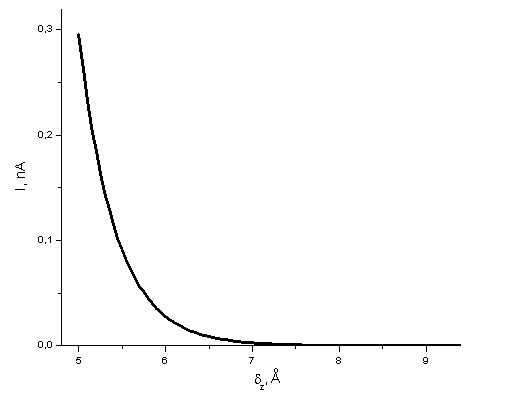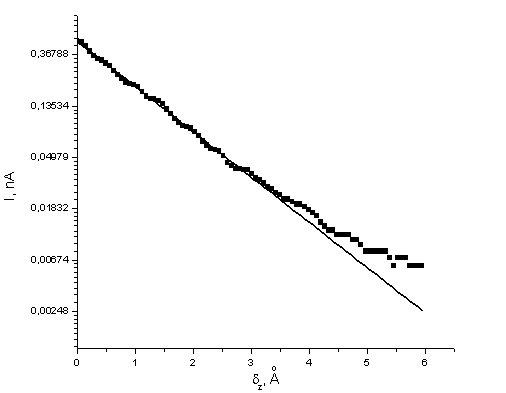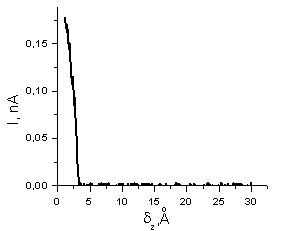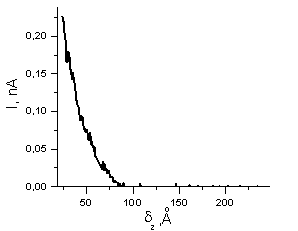1.3.2 Current-Distance Characteristic
Measurement of relation between tunneling current and tip-sample distance is carried out in
 spectroscopy mode. According to (11) from chapter 1.2.1, in absence of a condensate, a typical current-height relation is an exponential current decay (Fig. 1) with a characteristic length of a few angstrom [1, 2].
spectroscopy mode. According to (11) from chapter 1.2.1, in absence of a condensate, a typical current-height relation is an exponential current decay (Fig. 1) with a characteristic length of a few angstrom [1, 2].

Fig. 1. Theretical
 curve for Pt sample and Pt-Ro probe.
curve for Pt sample and Pt-Ro probe.
Inspecting an experimental
 curve, it is possible to estimate the potential barrier height
curve, it is possible to estimate the potential barrier height
 . If tip-sample bias
. If tip-sample bias
 is small enough, then according to chapter 1.2.2, tunneling current can be written as
is small enough, then according to chapter 1.2.2, tunneling current can be written as

(1)
where
 ,
,
 ,
,
 – contact area,
– contact area,
 – free electron mass,
– free electron mass,
 – elementary charge,
– elementary charge,
 – Planck's constant.
– Planck's constant.
From (1)
 can be expressed through some analytical function of
can be expressed through some analytical function of
 . Finding the natural logarithm of (1) and differentiate the result by
. Finding the natural logarithm of (1) and differentiate the result by
 one can obtain
one can obtain

(2)
If
 , then
, then
 can be expressed from (2) by following way
can be expressed from (2) by following way

(3)
where
 is experessed in m-1. Emphasize, that in most cases the condition
is experessed in m-1. Emphasize, that in most cases the condition
 realizes practically always. For instance, if
realizes practically always. For instance, if
 , then expression (3) will be correct at
, then expression (3) will be correct at
 .
.
Experimental
 curve for Pt-flim which was measured using Pt-Ro probe in STM (Solver P47) on air, is shown on Fig. 2.
curve for Pt-flim which was measured using Pt-Ro probe in STM (Solver P47) on air, is shown on Fig. 2.

Fig. 2. Experimental
 curve (semilogarithmic scale).
curve (semilogarithmic scale).
Solid line – approximation
 .
.
Substituting value of approximated straight line slope
 in (3), we obtain, that
in (3), we obtain, that
 . Theoretical value of
. Theoretical value of
 , in case, then both electrodes are produced from Pt, equals
, in case, then both electrodes are produced from Pt, equals
 . Thus, experimental value of
. Thus, experimental value of
 is lower by a factor about 6 than theoretical one. Most probably, the main reason of this difference is condensate presence on electrodes surface. Even for fresh surfaces of pyrolitic graphite at maximum
is lower by a factor about 6 than theoretical one. Most probably, the main reason of this difference is condensate presence on electrodes surface. Even for fresh surfaces of pyrolitic graphite at maximum
 values, the corresponding values of
values, the corresponding values of
 are less than several tenths of eV. These values are deliberately less than those known from high vacuum and low temperature STM experiments for the same samples and tips [3]. Values
are less than several tenths of eV. These values are deliberately less than those known from high vacuum and low temperature STM experiments for the same samples and tips [3]. Values
 of derived from experiments in air are close to those obtained using STM configured for electrochemical measurements in situ when liquid polar medium exists between sample and tip [3]. A condensate in the STM operating in air is evidently the analogue of such a medium. Thus, the condensate occurence on the sample surface results in the STM image quality deterioration and values of
of derived from experiments in air are close to those obtained using STM configured for electrochemical measurements in situ when liquid polar medium exists between sample and tip [3]. A condensate in the STM operating in air is evidently the analogue of such a medium. Thus, the condensate occurence on the sample surface results in the STM image quality deterioration and values of
 understatement.
understatement.
Frequently
 spectroscopy is used for a determination of tip quality (sharpness). Experimental
spectroscopy is used for a determination of tip quality (sharpness). Experimental
 curves, which are measured at investigation of HOPG surface using "good" and "poor" sharp tip of Pt-Ro probe, is shown on Fig. 3, 4.
curves, which are measured at investigation of HOPG surface using "good" and "poor" sharp tip of Pt-Ro probe, is shown on Fig. 3, 4.

Fig. 3.
 spectroscopy for a "good-shape" STM tip.
spectroscopy for a "good-shape" STM tip.

Fig. 4.
 spectroscopy for a "poor-shape" STM tip.
spectroscopy for a "poor-shape" STM tip.
Tip quality criterion is following: 1) if tunneling current drops twice at tip-sample distance less than 3 Å, then tip quality is very good; 2) if this distance is about 10 Å, then atomic resolution can be still obtained on HOPG using such STM tip; 3) if the current drops at distance equals or more than 20 Å, then this STM tip should be replaced or sharpened [4].
Summary.
- It is possible to estimate electron work-function of investigated material using
 spectroscopy (3).
spectroscopy (3). - The difference between experimental and table values of work-function is connected with the condensate presence on electrodes surface.
- In practice
 curve is used for a determination of STM tip quality (sharpness).
curve is used for a determination of STM tip quality (sharpness).
References.
- John G. Simmons. J. Appl. Phys. – 1963. – V. 34 1793.
- G. Binnig., H. Rohrer. Helv. Phys. Acta. – 1982, – V. 55 726.
- S. Yu. Vasilev, A. V. Denisov. Journal of technical physics. – 2000, – vol. 70, num. 1 (in Russian).
- NT-MDT. Solver P47 users guide.






